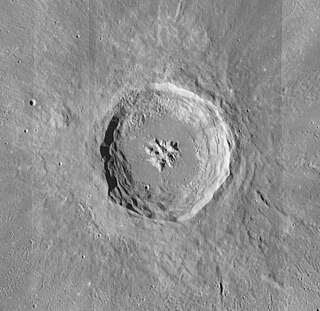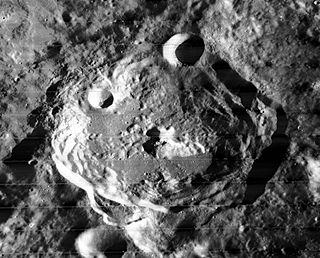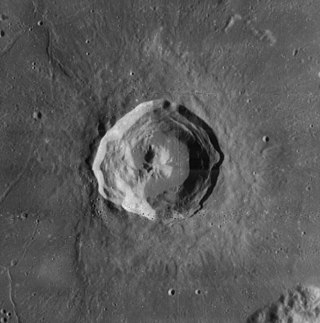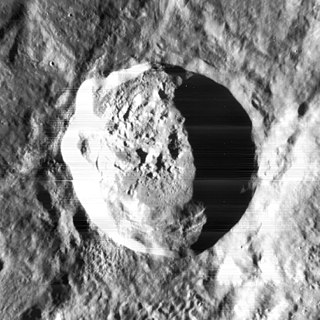
Anaxagoras is a young lunar impact crater that is located near the north pole of the Moon. It lies across the larger and more heavily worn crater Goldschmidt. To the south-southeast is Epigenes, and due south is the worn remains of Birmingham.

Faraday is a lunar impact crater in the southern highlands of the Moon. It was named after British chemist and physicist Michael Faraday. It lies across the southeast rim of the larger crater Stöfler, and the northwest rim of Faraday forms a wide rampart across the otherwise flat floor of Stöfler. To the east of Faraday is Maurolycus.

Aristillus is a prominent lunar impact crater that lies in the eastern Mare Imbrium. It was named after Greek astronomer Aristyllus. Directly to the south is the smaller crater Autolycus, while to the southwest is the large Archimedes. To the northeast are the craters Theaetetus and Cassini.

Autolycus is a lunar impact crater that is located in the southeast part of Mare Imbrium. The crater is named after the ancient Greek astronomer Autolycus of Pitane. West of the formation is Archimedes, a formation more than double the size of Autolycus. Just to the north is Aristillus, and the outer ramparts of these two craters overlap in the intermediate stretch of the lunar mare.

Eudoxus is a prominent lunar impact crater that lies to the east of the northern tip of the Montes Caucasus range. It is named after the Greek astronomer Eudoxus of Cnidus. It is located to the south of the prominent crater Aristoteles in the northern regions of the visible Moon. To the south is the ruined formation of Alexander, and the small crater Lamèch lies to the southwest.

Kepler is a lunar impact crater that lies between the Oceanus Procellarum to the west and Mare Insularum in the east. To the southeast is the crater Encke. Kepler is named for the 17th century German astronomer and mathematician Johannes Kepler.

Lichtenberg is an isolated lunar impact crater located in the western part of the Oceanus Procellarum. The nearest crater of note is Briggs to the south.

Römer is a lunar impact crater that is located to the north of the Sinus Amoris in the northeast section of the Moon. It was named after Danish astronomer Ole Rømer. It lies in the southwestern part of the mountainous region named the Montes Taurus. It was unofficially named as Atatürk by astronomer Hugh Percy Wilkins in his lunar map, possibly due to the fact that the Montes Taurus are located in Turkey. To the west-northwest is the crater-bay Le Monnier, on the eastern edge of Mare Serenitatis.

O'Day is a prominent lunar impact crater that is located on the far side of the Moon. It intrudes into the northwestern edge of Mare Ingenii, and the rim is lower on that side. To the northwest is the crater pair of Holetschek and Sierpinski. Southwest of O'Day lies the crater Seidel. It is named in honour of the American physicist Marcus O'Day.

Bürg is a prominent lunar impact crater in the northeast part of the Moon. It lies within the lava-flooded, ruined crater formation designated Lacus Mortis. To the south and southeast is the crater pair Plana and Mason. To the west, beyond the rim of Lacus Mortis, is the prominent crater Eudoxus.

Glushko is a young impact crater on the Moon attached to the western rim of the crater Olbers.

Godin is a lunar impact crater located just to the south of the crater Agrippa, on a rough upland region to the east of Sinus Medii. Its diameter is 34 km. The crater was named after 18th century French astronomer Louis Godin. The ruined crater Tempel lies to the northeast, on the east side of Agrippa. Due south is the flooded remains of Lade.

Harpalus is a young lunar impact crater that lies on the Mare Frigoris, at the eastern edge of the Sinus Roris. To the southeast at the edge of the mare is the small crater Foucault, and to the northwest on the opposite edge is the walled plain named South.

Palitzsch is a lunar impact crater that is located in the southeast part of the Moon, near the southeast rim of the crater Petavius. Just to the southwest of Palitzsch is Hase, while to the east-southeast is Legendre.

Ohm is a lunar impact crater that is located on the far side of the Moon. It lies to the south of the crater Comrie, and the satellite crater Comrie K is attached to Ohm's northeastern rim. To the northwest is the larger Shternberg, and to the southwest is Kamerlingh Onnes.

Schomberger is a prominent lunar impact crater that lies in the southern part of the Moon, in the area near the limb. It is located to the southwest of the crater Boguslawsky, and southeast of Simpelius. The relatively young satellite crater Schomberger A is nearly attached to the southern rim, and the much-aged Schomberger C lies just off the western rim.

Carpenter is a lunar impact crater in the northern part of the Moon, relatively close to the limb. At this position the crater is foreshortened and appears oval in shape. It is, however, very nearly circular in outline. The outer rampart to the south is adjoined to the old crater Anaximander, and the satellite formation Anaximander B lies along the western rim. To the northeast is Anaximenes.

Philolaus is a lunar impact crater that is located in the northern part of the Moon's near side. It lies within one crater diameter to the east-southeast of the flooded crater Anaximenes, and to the west of the smaller Anaxagoras. It overlies the older and heavily worn Philolaus C to the south.

Crookes is a lunar impact crater that lies on the Moon's far side as seen from the Earth. It lies just to the southwest of the giant crater Korolev. To the southwest of Crookes is McKellar.

Das is a lunar impact crater on the far side of the Moon. It is located to the north-west of the walled plain Chebyshev. To the south-west of Das is the irregular crater Mariotte, and Von der Pahlen lies to the east-northeast. The crater was named after Indian astronomer Anil Kumar Das.























